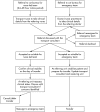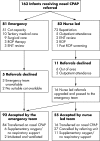Use of nasal continuous positive airway pressure during neonatal transfers
- PMID: 16204357
- PMCID: PMC2672687
- DOI: 10.1136/adc.2005.078022
Use of nasal continuous positive airway pressure during neonatal transfers
Abstract
Objective: To review all cases in which nasal continuous positive airway pressure (CPAP) was used as a means of respiratory support during land based ambulance transfers by a regional neonatal transport service.
Design: Retrospective study based on review of transport records.
Results: A total of 1175 transfer requests were received over the 21 month period. The infant in 163 of these cases was receiving nasal CPAP. Ninety two referrals were accepted by the doctor/nurse practitioner led team. Of these, 84 were transported while receiving nasal CPAP. Intervention during transport was required in three of these cases. Fifty five referrals were accepted by the nurse led team. Of these, 16 were transported while receiving nasal CPAP. Intervention was required in two cases.
Conclusion: There is a small but significant demand for transferring infants who are receiving nasal CPAP. Nasal CPAP appears to be a safe method of respiratory support for a carefully selected group of infants during land based ambulance transfers.
Conflict of interest statement
Competing interests: none declared
References
-
- Donoghue D, the A N Z N N.The report of the Australian and New Zealand Neonatal Network, 2000. Sydney: ANZNN, 2002
MeSH terms
LinkOut - more resources
Full Text Sources
Medical


